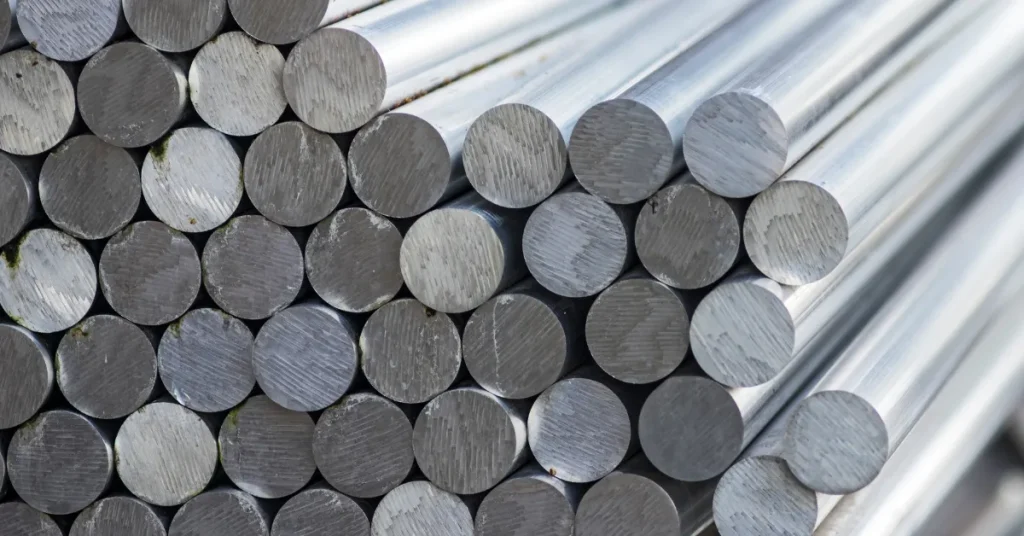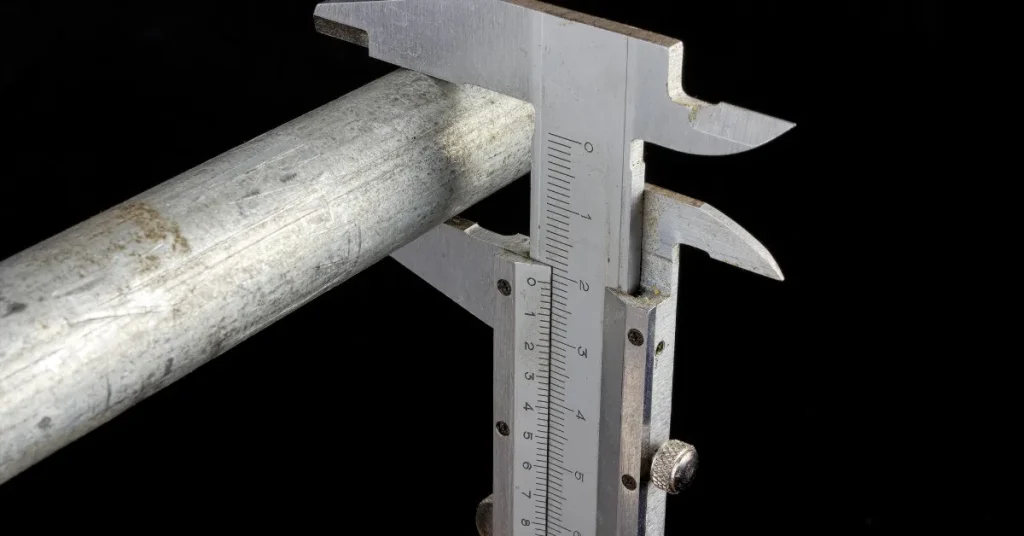22 gauge aluminum sheet has a standard thickness of 0.0253 inches, or approximately 0.643 millimeters. It’s crucial to note that in the world of metal fabrication, gauges are used to denote the thickness of sheet materials.
Comprehending the specific thickness of 22 gauge aluminum is essential for industries ranging from construction to crafts. This lightweight yet durable material is often chosen for projects where a balance between strength and weight is necessary.
Accurate knowledge of aluminum gauge is beneficial when ordering materials for manufacturing, ensuring that the specifications precisely match the project requirements.
As versatile as it is, 22 gauge aluminum provides a plethora of application possibilities without compromising on quality or ease of handling.

Gauge Measurements And Metal Thickness
Understanding metal thickness can seem tricky at first. Gauges don’t measure thickness in inches or millimeters. They follow a counterintuitive scale, where lower numbers mean thicker metal.
The Relationship Between Gauge Numbers And Thickness
Metal sheets are sold using a gauge number. These numbers don’t follow a linear scale. Instead, they represent different thicknesses. Let’s unravel this.
- Higher gauge number: thinner metal
- Lower gauge number: thicker metal
- 22 gauge aluminum typically measures 0.0253 inches or 0.643 mm
Comparing Different Materials By Gauge
Not all gauges are equal across materials. A 22 gauge aluminum isn’t the same as 22 gauge steel. Here’s a quick comparison.
| Material | 22 Gauge Thickness (inches) | 22 Gauge Thickness (mm) |
| Aluminum | 0.0253 | 0.643 |
| Steel | 0.0299 | 0.759 |
| Copper | 0.025 | 0.635 |
Remember that this table shows average values. Check with suppliers for precise measurements.
Aluminum Characteristics At 22 Gauge

Exploring the world of metals brings us to the versatile 22 gauge aluminum. This thickness strikes a balance between flexibility and strength. An understanding of the characteristics at this gauge provides insight into its potential applications and benefits.
Properties Of Aluminum At This Thickness
- Thickness measurement: 22 gauge aluminum is 0.0253 inches or 0.643 millimeters thick.
- Lightweight nature: Despite its metal composition, it is remarkably light, lending to its ease of use in various industries.
- Corrosion resistance: Aluminum naturally forms a protective oxide coating, making it resistant to rust.
- Thermal conductivity: This thickness allows for excellent heat dissipation, suitable for heat exchange applications.
- Electrical conductivity: While not as conductive as copper, it still serves well in electrical applications.
- Reflection capability: It reflects light and heat efficiently, which is ideal for lighting and thermal shielding.
Strength And Malleability Factors
The 22 gauge classification denotes a mid-range thickness where aluminum retains considerable strength while remaining highly workable. This dual-natured metal behaves robustly against everyday wear and tear while being pliable enough for crafting complex shapes.
| Metal Characteristic | Detail at 22 Gauge |
| Surface strength | Enough to withstand general pressure without warping |
| Flexibility | High enough for bending and forming shapes |
| Ductility | Allows stretching into wires or other thinner pieces |
| Toughness | Resists impact without cracking or breaking |
A sheet of 22 gauge aluminum lends itself to manufacturing processes such as stamping, bending, and cutting without sacrificing surface integrity. The malleability factor is a standout property, encouraging creative applications in sectors from automotive to art installations.
Converting Gauge To Inches Or Millimeters
Understanding the thickness of metal, like 22 gauge aluminum, can be confusing. But, it doesn’t have to be. Metal thickness is often measured in gauge. The larger the number, the thinner the metal.
To make it clear, let’s break down how gauge numbers convert to standard measurements of inches and millimeters.
How Gauge Translates To Standard Measurements
Gauge numbers can be turned into more familiar measurements. Here’s a straightforward way to understand this: a 22 gauge aluminum sheet is 0.0253 inches thick. That’s about as thick as a standard business card.
In millimeters, it’s approximately 0.643 mm. Remember, each metal type has its gauge thickness. For aluminum, the gauges to inches transformation looks like this:
| Gauge Number | Thickness in Inches | Thickness in Millimeters |
| 22 | 0.0253 | 0.643 |
| 20 | 0.0320 | 0.812 |
| 18 | 0.0403 | 1.024 |
Tools For Converting Gauge Sizes
Several tools can help you convert from gauge to inches or millimeters. Some of these are:
- Gauge conversion charts – Easily found online, these charts let you look up the thickness for different materials and gauges.
- Gauge measuring tools – These are special tools which precisely measure the thickness of the metal.
- Calipers – Useful for very accurate measurements, digital calipers can tell you the exact thickness of a metal sheet in your desired unit.
By using these tools, you can easily work with 22 gauge aluminum, or any other metal gauge size, and achieve the desired accuracy for your project.
Applications For 22 Gauge Aluminum
Imagine a material lightweight yet strong, flexible yet durable. That’s 22 gauge aluminum for you! It finds its place in numerous applications, shaping industries and hobbies alike.
Common Uses In Industries
22 gauge aluminum, a go-to material, offers a balance of workability and strength.
- Automotive parts: It helps make cars lighter.
- Electronics: It protects devices as casings.
- Construction: Builders use it for roofing and siding.
Its thin profile also suits intricate designs, like decorative panels.
Diy Projects And Home Applications
Creative minds celebrate 22 gauge aluminum.
At home, it transforms spaces and accessories:
- Wall art: Crafters cut and paint it for unique decor.
- Cabinet facings: It refreshes kitchen aesthetics.
- Custom shelving: It offers sturdy, sleek storage solutions.
Purchasing And Working With 22 Gauge Aluminum

Working with 22 gauge aluminum offers a perfect balance of workability and durability. Whether in crafting, construction, or DIY projects, understanding the thickness and how to handle this material is crucial for both hobbyists and professionals.
Let’s explore the considerations for purchasing and best practices for working with 22 gauge aluminum.
What To Consider When Buying 22 Gauge Aluminum
Aluminum’s popularity springs from its lightweight and corrosion-resistant qualities. Before buying 22 gauge aluminum, it’s essential to note a few key points:
- Measurements: 22 gauge equals 0.0253 inches or 0.643 mm in thickness.
- Quality: Check for material consistency and surface smoothness.
- Grade: Determine the aluminum alloy suitable for your project’s needs.
- Size: Aluminum sheets come in various sizes, ensure to select dimensions that minimize waste.
Tips For Cutting And Shaping
Working with 22 gauge aluminum requires precision and care. Here’s how to achieve the best results when cutting and shaping:
- Tools: Use tin snips for straight cuts or nibblers for shapes.
- Safety: Wear gloves and protective eyewear to prevent injury.
- Marking: Clearly draw cutting lines with a non-permanent marker.
- Sanding: Smooth edges with fine-grit sandpaper after cutting.
| Tool | Use |
| Tin Snips | Straight cuts |
| Nibblers | Curved or intricate shapes |
Remember, always measure twice and cut once to ensure high precision and reduced material waste. With these guidelines, your 22 gauge aluminum project will take shape just as you envision.
FAQs About How Thick Is 22 Gauge Aluminum
What Thickness Is 22 Gauge?
22 gauge metal has a standard thickness of 0. 0253 inches or approximately 0. 643 millimeters.
How Thick Is A 22 Gauge Aluminum Sheet?
A 22 gauge aluminum sheet is typically 0. 0253 inches or 0. 643 mm thick.
How Thick Is 24 Gauge Aluminum?
24 gauge aluminum typically measures 0. 020 inches or 0. 51 millimeters in thickness.
How Thick Is 20 Gauge Aluminum In Inches?
20 gauge aluminum measures approximately 0. 032 inches thick.
Conclusion
Understanding the thickness of 22 gauge aluminum is crucial for your project’s success. At 0. 0253 inches or approximately 0. 643 millimeters, this material strikes a balance between durability and pliability.
Remember this specification for informed choices in your construction or crafting endeavors.
Quality outcomes start with the right materials—choose wisely!
Resources:
1. https://www.nrc.gov/docs/ML1815/ML18153B271.pdf
